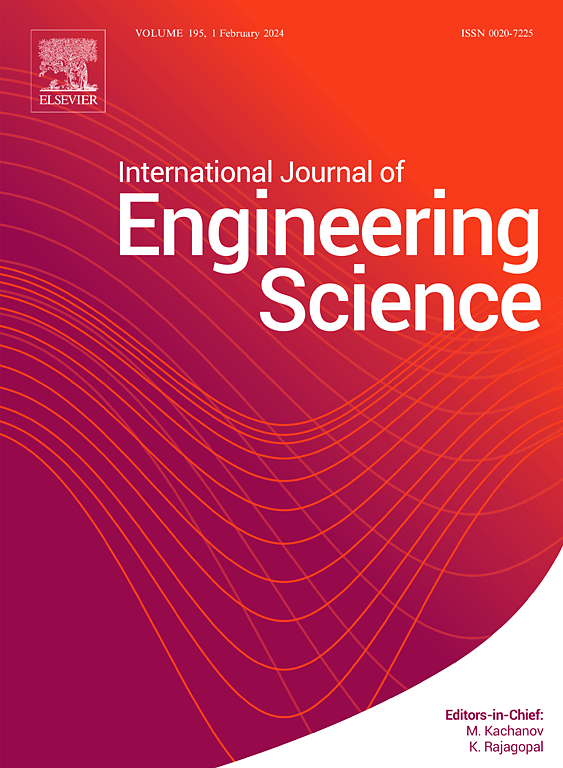Creep fracture entropy: A thermomechanical damage-based failure index
IF 5.7
1区 工程技术
Q1 ENGINEERING, MULTIDISCIPLINARY
International Journal of Engineering Science
Pub Date : 2025-08-29
DOI:10.1016/j.ijengsci.2025.104376
引用次数: 0
Abstract
This paper presents an analytical framework for thermodynamical modeling of creep damage and fracture in materials through the lens of entropy production. Building on the second law of thermodynamics and principles of irreversible processes, the study establishes a unified coupling between a phenomenological damage law and continuum damage mechanics. The model links creep deformation to internal entropy generation and introduces a process-dependent damage exponent to ensure physically consistent and mathematically robust damage evolution. A key contribution is to introduce Creep Fracture Entropy (CFE)—a novel, material-specific thermodynamic index that serves as a reliable predictor of creep failure. By deriving time-dependent expressions for strain, strain rate, and entropy production, the model captures the full progression of creep behavior, without requiring empirical stage segmentation. The model is validated against a range of experimental data from various alloys, manifesting strong agreement with the observed strain and entropy trends. Notably, the calculated CFE values remain confined within a narrow range for each material, highlighting their intrinsic nature of constancy and reliability as fracture indicators. The thermodynamic formulation presented here enhances predictive accuracy for creep life assessment, emphasizing entropy as a pivotal damage variable in irreversible thermodynamics.
蠕变断裂熵:一种基于热力学损伤的失效指标
本文提出了一种通过熵产生透镜对材料蠕变损伤和断裂进行热力学建模的分析框架。在热力学第二定律和不可逆过程原理的基础上,建立了现象学损伤规律与连续体损伤力学的统一耦合。该模型将蠕变变形与内部熵生成联系起来,并引入了一个过程相关的损伤指数,以确保物理上的一致性和数学上的鲁棒性损伤演化。一个关键的贡献是引入蠕变断裂熵(CFE)——一种新的、特定于材料的热力学指标,可以作为蠕变破坏的可靠预测指标。通过推导应变、应变率和熵产的时间相关表达式,该模型捕捉了蠕变行为的全部进展,而不需要经验阶段分割。该模型与各种合金的一系列实验数据进行了验证,表明与观察到的应变和熵趋势非常吻合。值得注意的是,每种材料的计算CFE值仍然局限在一个狭窄的范围内,突出了它们作为断裂指标的固有稳定性和可靠性。本文提出的热力学公式提高了蠕变寿命评估的预测精度,强调熵是不可逆热力学中关键的损伤变量。
本文章由计算机程序翻译,如有差异,请以英文原文为准。
求助全文
约1分钟内获得全文
求助全文
来源期刊

International Journal of Engineering Science
工程技术-工程:综合
CiteScore
11.80
自引率
16.70%
发文量
86
审稿时长
45 days
期刊介绍:
The International Journal of Engineering Science is not limited to a specific aspect of science and engineering but is instead devoted to a wide range of subfields in the engineering sciences. While it encourages a broad spectrum of contribution in the engineering sciences, its core interest lies in issues concerning material modeling and response. Articles of interdisciplinary nature are particularly welcome.
The primary goal of the new editors is to maintain high quality of publications. There will be a commitment to expediting the time taken for the publication of the papers. The articles that are sent for reviews will have names of the authors deleted with a view towards enhancing the objectivity and fairness of the review process.
Articles that are devoted to the purely mathematical aspects without a discussion of the physical implications of the results or the consideration of specific examples are discouraged. Articles concerning material science should not be limited merely to a description and recording of observations but should contain theoretical or quantitative discussion of the results.
 求助内容:
求助内容: 应助结果提醒方式:
应助结果提醒方式:


